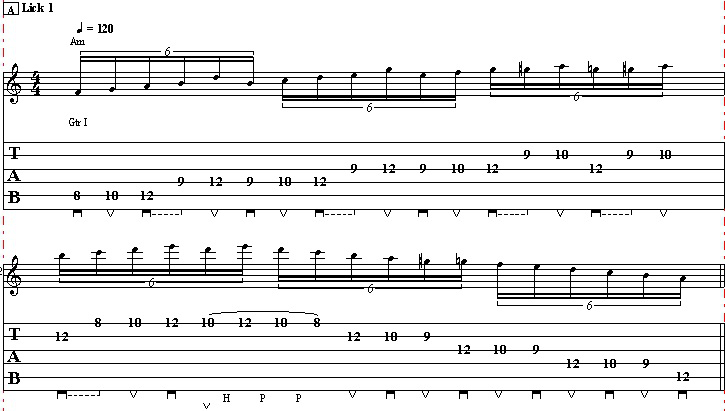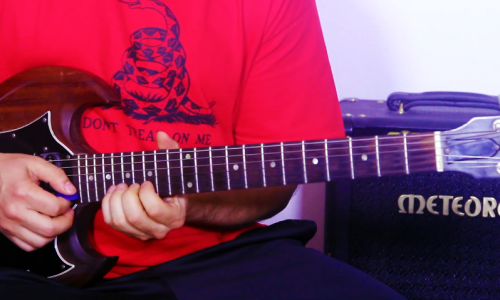Learn to play a killer arpeggio lick in D minor with Guitar Control instructor Darrin Goodman, aka Uncle D. Be sure to get the free tabs to go along with the step by step video instruction and you will be rockin’ this killer arpeggio lick in record time.

Introduction
How’s it going everybody? This is Darrin with GuitarControl.com bringing you this video lesson and today I’ve got a fun little arpeggio lick for you in the key of D.
Right now Guitar Control is giving away this really cool free chord chart, there’s a link in the description where you can get yours. It’s in PDF format and has every chord you could ever need I’ll neatly compiled into one sheet. So you can download it, you can print it off and put a copy in your gig bag and put a copy where you practice so just whatever situation you’re in you have any chord you need at a glance and it’s free download.
So be sure to click on the link in the description for the tabs and let’s get close up and take a look at this.
Arpeggio Lick In D Minor
All right, so starting off we’re going to do a D minor arpeggio. So for those of you who like know how to play Stairway to Heaven this is like the very first chord, I’ve just moved up here so I’m on the 12th fret of the D string with my third finger and then my first finger is going to pick up the G, B and high E strings all at the 10th fret. Now when we play this we don’t want we don’t want to just have a sound like a chord, we want the notes to be separated. So third finger picking this note up and then when I go to the G string I release the D string to mute it. Now when I play the G string here I’m not just barring. I’m playing the fret on the G string, but the B string and the high E strings are both muted. And then I’m going to roll my finger up now I’m picking up that B string and the high E string is muted. So on the G string I’m going to roll it up again and now I’m fretting the highest string and the B and the G string are both muted. All right so when we get to the top of that then we’re going to hammer on to the 13th fret on the high E string with your pinky. Now another thing too when you’re when you’re making the approach up is that
I’m also heavily palm muting so that way I’m just trying to isolate those notes separately so they’re not ringing out or I’m not hearing string unwanted string noise. And as far as the technique itself I’m not going to get too deeply into this. There’s lots of lessons on here on the technique for this, but it’s just one long continuous downstroke or one long continuous upstroke. So what I do is I just let the pick come to a rest on the next string and then over time you just get faster at doing it. So we do the hammer-on there and then we slide to the 15th fret. Now what that’s setting us up for is now we’re going to be doing a C major arpeggio, but now it’s going to be a different voicing. So if you see my arpeggio series these are the three string arpeggios. So we’re sliding up here to the 15th fret and then at the same time you want to drop your first finger the 12th fret here and now we’re going to pull-off to the 12th fret and then our middle finger is going to go to the 13th fret of the B string and then our first finger to the 12th fret of the G string; so it looks like a D major shape second inversion Triad. Down to the G string and then back up, hammer and slide to the 17th fret. Now we slide to the 17th fret then at the same time we want to drop our first finger here onto the 13th fret of the high E string because now we’re going to be doing a D minor. So we’re up here at the 17th fret and we’re going to pull-off here to the 13th fret. So now instead of being like a like a D major shape it’s going to be like a D Minor shape. We’re flattening the third to make it minor and then to the 15th fret on the B string, 14th fret on the G string and then back up and hammer and then tap the 22nd fret. So what we’re doing is we’re tapping one, two, three, four, five frets up because this is movable since we don’t have any open strings we can move this. So starting here, this is where we started this Dm here. So we can move this around wherever we wanted to if we moved it here this is an A. So it’s movable around in different places. The further you are down this way I think it’s more difficult to play and then up here it gets more difficult too and then if you have a 24 fret guitar then you can do it in E minor because you could still do it here, it’s just the you don’t have enough frets to tap the note here. So yeah, it’s not too terribly difficult to play. I mean if you’re if you’re completely new to this technique I’m sure it would be difficult, but I tried to make it something that was a little bit simpler, but so there’s things that you could do to this to make it fancier. You could play the extended arpeggios and just add in the D string and the A string and again these are series that I’ve already done before with all these shapes and stuff that they’re here on the channel.
Conclusion
All right, so there you have it. A pretty cool D minor arpeggio lick and like I said it’s movable. So you can move around any different keys and do different stuff with it. So if you like this lesson be sure to give me a thumbs up and leave a comment down below if you have any questions about this or other guitar related topics. If you’ve not already done so please subscribe to the channel and hit that notification bell so you don’t miss any of the content that we upload throughout the week. Well that is all I have for you today. Thanks for watching and have a great day.



